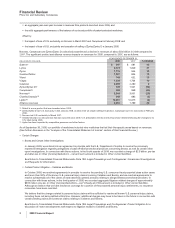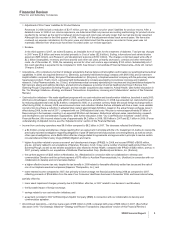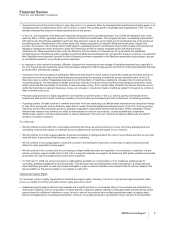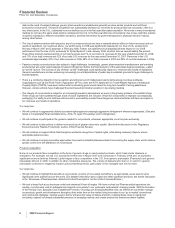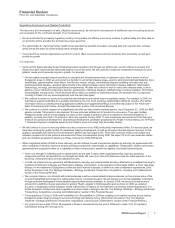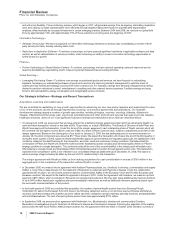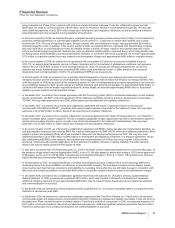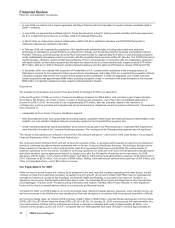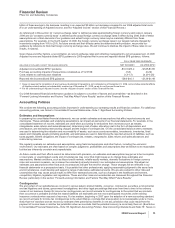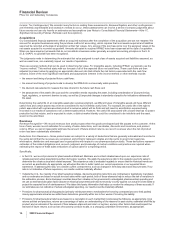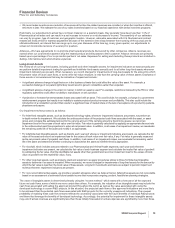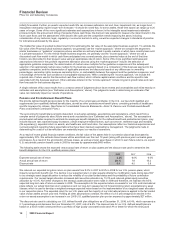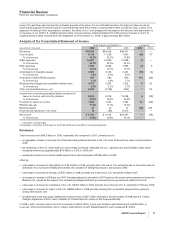Pfizer 2008 Annual Report Download - page 9
Download and view the complete annual report
Please find page 9 of the 2008 Pfizer annual report below. You can navigate through the pages in the report by either clicking on the pages listed below, or by using the keyword search tool below to find specific information within the annual report.
Financial Review
Pfizer Inc and Subsidiary Companies
Regulatory Environment and Pipeline Productivity
The discovery and development of safe, effective new products, as well as the development of additional uses for existing products,
are necessary for the continued strength of our businesses.
•We are confronted by increasing regulatory scrutiny of drug safety and efficacy even as we continue to gather safety and other data on
our products, before and after the products have been launched.
•The opportunities for improving human health remain abundant as scientific innovation increases daily into new and more complex
areas and as the extent of unmet medical needs remains high.
•Our product lines must be replenished over time in order to offset revenue losses when products lose their exclusivity, as well as to
provide for growth.
Our response:
•As the world’s largest privately funded biopharmaceutical operation, and through our global scale, we will continue to develop and
deliver innovative medicines that will benefit patients around the world. We will continue to make the investments necessary to serve
patients’ needs and to generate long-term growth. For example:
OWe have taken important steps to prioritize our research and development portfolio to maximize value. After a review of all our
therapeutic areas, in 2008, we announced our decision to exit certain disease areas—anemia, atherosclerosis/hyperlipidemia, bone
health/frailty, gastrointestinal, heart failure, liver fibrosis, muscle, obesity, osteoarthritis (disease modifying concepts only) and
peripheral arterial disease—and give higher priority to the following disease areas: Alzheimer’s disease, diabetes, inflammation/
immunology, oncology, pain and psychoses (schizophrenia). We also will continue to work in many other disease areas, such as
asthma, chronic obstructive pulmonary disorder, genitourinary, infectious diseases, ophthalmology, smoking cessation, thrombosis
and transplant, among others. These decisions did not affect our portfolio of marketed products, the development of compounds
currently in Phase 3 or any launches planned over the next three years.
OWe continue to review our products for potential new indications and submit them for regulatory review. For example, in 2008, we
submitted a supplemental filing for a pediatric indication to the U.S. Food and Drug Administration (FDA) for Geodon. (For further
information about our pending new drug applications (NDAs) and supplemental filings, see further discussion in the “Revenues—
Major Pharmaceutical Products—Product Developments” section of this Financial Review.)
OWe continue to conduct research on a significant scale that can help redefine medical practice. As of December 31, 2008, our R&D
pipeline includes 106 projects in development: 84 new molecular entities and 22 product-line extensions. They span multiple
therapeutic areas, and we are leveraging our status as the industry’s partner of choice to expand our licensing operations. In
addition, we have more than 170 projects in discovery research. During 2008, 11 new compounds were advanced from discovery
research into preclinical development, 26 preclinical development candidates progressed into Phase 1 human testing and 19 Phase
1 clinical development candidates advanced into Phase 2 proof-of-concept trials and safety studies.
•We will continue to focus on reducing attrition as a key component of our R&D productivity improvement effort. For several years, we
have been revising the quality hurdles for candidates entering development, as well as throughout the development process. As the
quality of candidates has improved, the development attrition rate has begun to fall. Three new molecular entities and multiple new
indication programs for in-line products advanced into Phase 3 development during 2008. We expect 15 to 20 new molecular entities
and new indication programs to advance to Phase 3 during the 2008-2009 period.
•While a significant portion of R&D is done internally, we will continue to seek to expand our pipeline by entering into agreements with
other companies to develop, license or acquire promising compounds, technologies or capabilities. Collaboration, alliance and license
agreements and acquisitions allow us to capitalize on these compounds to expand our pipeline of potential future products.
ODue to our strength in marketing and our global reach, we are able to attract other organizations that may have promising
compounds and that can benefit from our strength and skills. We have more than 400 alliances across the entire spectrum of the
discovery, development and commercialization process.
OIn 2008, we entered into an agreement with Medivation to develop and commercialize Dimebon, Medivation’s investigational drug for
treatment of Alzheimer’s disease and Huntington’s disease, and Auxilium, to develop and commercialize Xiaflex, a novel, late-stage
biologic, for the treatment of Dupuytren’s contracture and Peyronie’s disease, in addition to other collaboration agreements. (See
further discussion in the “Our Strategic Initiatives—Strategy and Recent Transactions: Acquisitions, Licensing and Collaborations”
section of this Financial Review.)
OWe recognize that our core strength with small molecules must be complemented by large molecules, as they involve some of the
most promising R&D technology and cutting-edge science in medical research. We will expand our internal capabilities in biologics
through business development where attractive opportunities become available. In January 2009, we announced that we have
entered into a definitive merger agreement to acquire Wyeth, a leader in biotherapeutics and vaccines. In 2008, we acquired
Encysive, a biopharmaceutical company, whose main product (Thelin) is for the treatment of pulmonary arterial hypertension. For
further discussion of these and other acquisitions we have made in biologics, see the “Our Strategic Initiatives—Strategy and Recent
Transactions: Acquisitions, Licensing and Collaborations” section of this Financial Review.
OThe acquisitions of Coley in 2008 and PowderMed Ltd. (PowderMed) in 2006 are enabling us to explore vaccines across various
therapeutic areas using the acquired vaccine technology and delivery device. (See further discussion in the “Our Strategic
Initiatives—Strategy and Recent Transactions: Acquisitions, Licensing and Collaborations” section of this Financial Review.)
OOur goal is to have a total of 24 to 28 programs in Phase 3 development by the end of 2009 and to make 15 to 20 regulatory
submissions during 2010 through 2012.
2008 Financial Report 7




